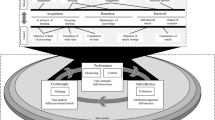Abstract
Research has shown that the most successful students are those who have a propensity to control their own effort to learn. They take personal responsibility for regulating the way in which they approach their studies. Traditionally, it was believed that such self-regulation occurred only through the practice of active, deliberate learning strategies. This study explores an expanded conception of self-regulated learning, one that includes not only the active, strategic control but an internally driven or dynamic disposition to learn as well. Its findings suggest that the natural dynamic component, reflecting qualities such as curiosity, enthusiasm, willingness to take risks, and persistence, actually underlies and drives the strategic behavior. Whether these dynamic qualities can be taught, just as active self-regulation, remains a question. In this study where dynamic qualities were valued highly and the environment was supportive and expressive of a culture of learning, initial findings demonstrated that a sizable portion of students who were low dynamic at pre course changed to high dynamic by post course.
Similar content being viewed by others
References
Borkowski, J. G., Carr, M., & Pressley, M. (1987). “Spontaneous” strategy use: Perspectives from metacognitive theory. Intelligence, 11, 61-75.
Garcia, T., & Pintrich, P. R. (1992). Critical thinking and its relationship to motivation, learning strategies, and classroom experience. Paper presented at the Centennial Annual Convention of the American Psychological Association, Washington, DC. (ERIC Document Reproduction Service No. ED 024 644)
Halpern, D. F. (1996). Thought and knowledge: An introduction to critical thinking. Mahwah, NJ: Lawrence Erlbaum.
Iran-Nejad, A. (1990). Active and dynamic self-regulation of learning processes. Review of Educational Research, 60, 537-602.
Iran-Nejad, A., & Chissom, B. S. (1992). Contributions of active and dynamic self-regulation to learning. Innovative Higher Education, 17, 125-136.
Livingston, J. A., & Van Zile-Tamsen, C. M. (1998, August). Correlates of Active and Dynamic Self-Regulation. Poster presented at the annual convention of the American Psychological Association, San Francisco, CA.
McCombs, B. L. (1988). Motivational skills training: Combining metacognitive, cognitive, and affective learning strategies. In C. E. Weinstein, E. T. Goetz, & P. A. Alexander (Eds.), Learning and study strategies: Issues in assessment, instruction, and evaluation (pp. 141-169). San Diego: Academic Press.
McCombs, B. L., & Marzano, R. J. (1990). Putting the self in self-regulated learning: The self as agent in integrating will and skill. Educational Psychologist, 25, 51-69.
Office of Institutional Analyses. (1997). Methods of Inquiry retention study: An analysis of the 1991-1992 cohort. Unpublished research report, State University of New York at Buffalo.
Paul, R. (1992). Critical thinking: What every person needs to survive in a rapidly changing world. Santa Rosa, CA: Foundation for Critical Thinking.
Pintrich, P. R., Smith, D. A., Garcia, T., & McKeachie, W. J. (1991). A manual for the use of the Motivated Strategies for Learning Questionnaire (MSLQ). Ann Arbor, MI: National Center for Research to Improve Post Secondary Teaching and Learning. (ERIC Document Reporduction Service No. ED 338 122)
Pressley, M. (1995). More about the development of self-regulation: Complex, long-term, and thoroughly social. Educational Psychologist, 30, 201-212.
Tishman, S., & Andrade, A. (1995). Thinking dispositions: A review of current theories, practices, and issues. Unpublished manuscript, Harvard University.
Van Zile-Tamsen, C. M. (1996). Metacognitive self-regulation and the daily activities of college students. Unpublished doctoral dissertation, State University of New York at Buffalo.
Weinstein, C. E., Cubberly, W. E., Wicker, F. W., Underwood, V. L., Roney, L. K., & Duty, D. C. (1981). Training versus instruction in the acquisition of cognitive learning strategies. Contemporary Cognitive Psychology, 6, 159-166.
Winne, P. (1995). Inherent details in self-regulated learning. Educational Psychologist, 30, 173-187.
Wolters, C. A. (1998). Self-regulated learning and college students' regulation of motivation. Journal of Educational Psychology, 90, 224-235.
Zimmerman, B. (1995). Self-regulation involves more than metacognition: A social cognitive perspective. Educational Psychologist, 30, 217-221.
Author information
Authors and Affiliations
Rights and permissions
About this article
Cite this article
Schapiro, S.R., Livingston, J.A. Dynamic Self-Regulation: The Driving Force Behind Academic Achievement. Innovative Higher Education 25, 23–35 (2000). https://doi.org/10.1023/A:1007532302043
Issue Date:
DOI: https://doi.org/10.1023/A:1007532302043



